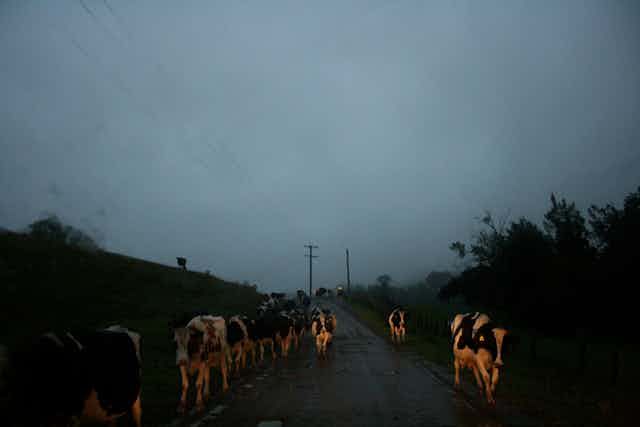Australia has some of the world’s most conservative restrictions on using antimicrobial drugs in livestock. Possibly as a consequence, we have some of the lowest rates in the world of antibiotic resistance in the bacteria (such as Salmonella and Campylobacter) that cause food poisoning.
Australian producers do not use broad-spectrum antibiotics such as fluoroquinolones or gentamicin in livestock production. The antibiotic ceftiofur is governed by strict label requirements.
However, Australia is increasingly importing fresh food, including vegetables, from countries where these antimicrobial drugs are used indiscriminately in both animals and humans. Australia’s primary producers are under great pressure. They have to compete with cheap imported products that are often of inferior quality and may come from countries where the use of antibiotics in livestock is not so tightly regulated.
Australia has no coordinated national program monitoring antibiotic resistance in livestock or companion animal pathogens. Resistance in these key pathogens is a major driver throughout the world of the use of antimicrobial drugs for animals as well as humans.
Just like doctors, when veterinarians encounter disease in animals they may often take samples, such as urine from a dog with suspected infection of the bladder, and submit the samples to a specialised veterinary microbiology laboratory. The laboratory will culture the urine, identify the bacteria and tell the veterinarian which antibiotics the organism is sensitive to. This helps them make the correct treatment choice.
Right now, most veterinary microbiology laboratories in Australia are only keeping the bacteria they isolate from animals for a short time. Saving the bacteria for longer means we can accurately measure rates of resistance to all classes of antibiotic across the nation.
In a new project, a network of over 20 university-based, private and government veterinary microbiology laboratories will submit all the isolates they obtain to The University of Adelaide. Such “routine surveillance” is already practiced in Australia for Escherichia coli (E. coli) and staphylococci obtained from cases of infection in humans. It is a major weapon in the fight against antibiotic resistance.
Previous small-scale studies have shown the risk of antimicrobial resistance organisms coming through the Australian food-chain is extremely small. However, a national surveillance programme is required to confirm this. It will also quickly identify any hot pockets of emerging resistance so they can be immediately dealt with.
The hunt for superbugs in Australian animals may confirm that we have low rates of resistance to important classes of drug relative to other countries. This will be good news for both our producers and consumers. But we should not be complacent.
Just like their medical counterparts, veterinarians are end users of antibiotics. They need to work in tandem with health-care professionals so that they don’t overprescribe antibiotics, practice good infection control such as regular hand disinfection and investigate viable alternatives to antibiotics for the treatment and control of bacterial diseases, particularly in livestock.
One overlooked but important area is whether resistance in E. coli and staphylococci is causing infections in companion animals.
Treatment for our loved pets when they succumb to illness closely mirrors how we treat people in hospitals. Recent research has shown that humans can readily transmit E. coli that cause urinary tract infections and staphylococci that cause skin and soft tissue infections to their pets. Pets can then transmit them back to humans.
The E. coli strains normally live in the intestine. There, they do no harm. But they cause infections when they gain entry to a normally sterile site, such as the bladder. Highly resistant strains have emerged and spread globally in humans and have recently been identified in dogs. The problem is currently small, but increased vigilance is required to keep it that way.
Over the next few years, we hope the animal surveillance data will positively influence the prescribing practices of veterinarians in the field, whether they work with livestock, companion animals, or both. It will also be used as an educational resource in veterinary schools to spread prudent use of antibiotics to the next generation of veterinarians.
This is the fourth article in Superbugs vs Antibiotics, a series examining the rise of antibiotic-resistant superbugs. Click on the links below to read the other instalments.
Part one: Washing our hands of responsibility for hospital infections
Part two: Superbugs, human ecology and the threat from within
Part three: We can beat superbugs with better stewardship of antibiotics
Part five: The last stand: the strongest of the superbugs and their antibiotic nemesis
Part six: Unblocking the pipeline for new antibiotics against superbugs
Part seven: A peek at a world with useless antibiotics and superbugs
Part eight: Trading chemistry for ecology with poo transplants
Part nine: New antibiotics: what’s in the pipeline?

